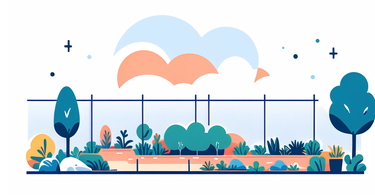Introduction to Garden Fence Installation
The Importance of Secure Fence Posting
Secure fence posts are vital for a sturdy garden barrier. They lend strength and stability, holding the fence upright against wind and weather. In the US, secure posting is key to thwart pests and ensure privacy. A well-set post can last for years, making it a smart long-term choice. For 14ft fences, strong posts are even more crucial due to the fence's height. They support the weight and resist pressure applied by the fence. Proper installation means your garden remains safe and looks great.

Understanding the US Soil Conditions
Soil types in the U.S. vary widely, affecting fence stability. From the clay-heavy soils in the South to sandy conditions along coastlines, each area demands specific consideration. For instance, soil with a lot of clay can expand and contract. This movement can affect fence foundation. In contrast, sandy soils may require deeper posts for support. It's vital to know local soil to plan fence posts that last. This knowledge impacts material choice and installation depth.
Step-by-Step Guide to Installing 14ft Garden Fences
Selecting the Right Fence Post Materials
When starting your 14ft garden fence project, the material of the fence posts is critical. In the US, common choices include wood, metal, and vinyl. Each has pros and cons.
- Wood: Natural look, can be painted or stained but may rot over time.
- Metal: Durable and sturdy, often steel or aluminum, resistant to pests, but can corrode.
- Vinyl: Needs little upkeep, won't rust or decay, but can be costlier and less sturdy in high winds.
Pick materials based on your climate, soil type, and design wishes. It's best to think long term. A poor choice now can mean more work and cost later.
Detailed Installation Process for Inground Fence Posts
To properly install inground fence posts for a 14ft garden fence, follow these steps:
- Marking the Layout: Begin by plotting out where your fence will go. Use flags or spray paint to mark the spot of each post.
- Digging Post Holes: With your layout marked, it's time to dig. Ensure holes are deep enough to support the height of your fence – usually about a third of the post's height.
- Setting Posts in Concrete: Pour concrete into the hole and set the post. Use a level to keep it perfectly vertical as the concrete sets.
- Securing Posts: Once the concrete has cured, secure the fence posts. This may involve attaching brackets or directly securing fence panels.
- Final Inspection: Check each post for stability and make sure the fence is straight and even.
By carefully following these steps, your 14ft fence will have a strong foundation resistant to the elements.
Post-Installation Maintenance and Care
Once your 14ft garden fence is up, keep it sturdy and stylish over time with proper care. Here are key steps to maintain the life of your inground posts:
- Inspect the fence posts regularly for signs of damage or rot. Pay particular attention to the base where moisture can cause decay more quickly.
- Clean the fence regularly to prevent dirt buildup and mild splashes that can cause mold or mildew, especially during wet seasons.
- Repaint or stain your fence as necessary to protect the wood against the elements and to maintain its appearance.
- Check for loosened or corroded hardware, and tighten or replace as needed to ensure your fence remains secure.
- Regularly trim vegetation around the fence posts to prevent excessive moisture and growth that can weaken the posts.
- If you live in an area with freezing temperatures, inspect the soil around the posts for heave and adjust if necessary to prevent misalignment.
Advanced Techniques and Best Practices
Designing an Effective Garden Fence Layout
When designing a garden fence layout, consider visibility, access, and aesthetics. Start with a clear plan on paper to map out the fence line, gate placement, and key features. Orient the layout for optimal sunlight and air flow, ensuring plants aren't shaded. Include pathways for easy navigation. Use the geography of the land to your advantage; follow the natural contours for a seamless look. Factor in growth: leave room for plants to expand. Remember to adhere to local zoning laws relating to fence height and boundaries. Lastly, consult with neighbors to prevent disputes over the fence line.
Incorporating Landscaping Features with Fence Installation
To enhance your garden's beauty, consider how a fence can work with the landscape. Here's how:
- Plan for Harmony: Choose a fence design that complements your garden's theme.
- Gates as Focal Points: Use gates as charming entryways that invite exploration.
- Integrate Plant Life: Blend fencing with trellises for climbing plants, creating a living wall.
- Use of Color: Match or contrast fence colors with blooms for visual appeal.
- Lighting Effects: Install lights on fence posts for ambiance and safety.
By keeping these tips in mind, you can create a fence that's both functional and a key part of your garden's allure.
Long-Term Durability and Longevity Considerations
For your garden fence to last, follow these tips. Use weather-resistant materials to prevent rot and rust. Apply a protective coating to shield from harsh elements. Check posts seasonally for signs of wear. Replace damaged parts early to maintain fence integrity. Keep vegetation clear to avoid wood rot and pest nesting. Install adequate drainage to prevent water damage. With care, your fence can stand for years.
